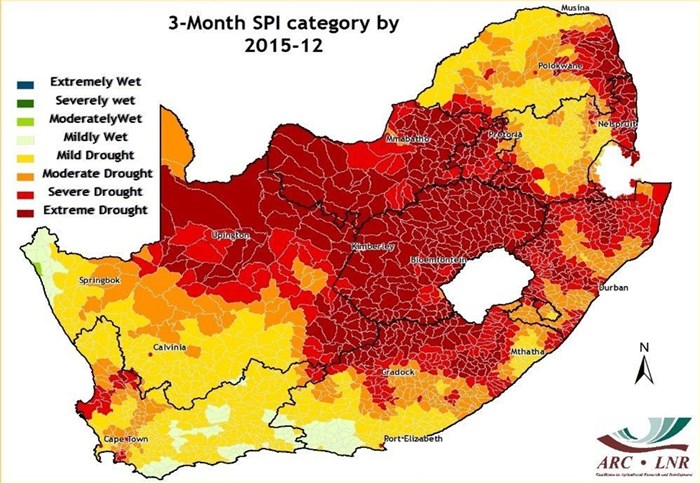Governments, businesses and communities need to increase their awareness of the pending El Niño that is currently manifesting in the central Pacific Ocean, South African climate experts urge. The El Niño-Southern Oscillation (ENSO) is one of the most important climate phenomena on Earth due to its ability to influence global atmospheric circulation. El Niño and La Niña are the warm and cool phases of a recurring climate pattern across the tropical Pacific - the ENSO.

Image source: Pixabay from
PexelsResearchers in South Africa and across the globe have, through regular monitoring of the ENSO system, presented evidence that a moderate-to-strong El Niño is developing in 2023.
Speaking at the El Niño 2023 Summit held at the University of Pretoria, CSIR senior researcher and Access director, Dr Neville Sweijd, emphasised the need for early preparation in anticipation of the potential impacts of the 2023 El Niño in South Africa and its neighbouring countries.
Professor Willem Landman from the University of Pretoria explained that the challenge is that while there is a well-understood relationship between ENSO and extreme weather in South Africa, this is not a straightforward relationship and the extent of impacts vary greatly. However, most previous droughts in the summer rainfall regions of the country, and seasons with a high frequency of heat waves days, are associated with El Niño events.
Sweijd added that “What is different and concerning this year is that published data are showing that global average sea surface temperatures have reached unprecedented levels in May and June 2023 and already, records for June air temperatures are being broken in the northern hemisphere. This means that the El Niño is likely to be unusually strong.”

This figure shows which parts of the country were most affected by the 2015/16 El Nino event. Much of the central parts of the country, including the western maize production regions, experienced extreme drought conditions from October to December, while the north-eastern parts were less negatively affectedPhoto credit: Johann Malherbe, ARC
“Although we are certain that an El Niño is manifesting, we are uncertain about what impact it will have at this stage. In the past (2015/16), the impact was severe and although we cannot say yet that this season will be equally affected, we must preempt the potential impact. It is quite unpredictable by nature, but there is a general pattern that researchers in South Africa have been studying,” Sweijd said. While the changes in weather and climate are continuous, the concern is whether, in the long term under the influence of global warming, this type of event will occur more frequently, as climate models suggest.
Potential impact on agriculture, food security
Colleagues from the Agricultural Research Council (ARC) and the South African Weather Service (SAWS) showed how previous ENSO events affected the seasonal rainfall and temperature in the country and were able to demonstrate the impact of the 2015/16 El Niño on agricultural production, human health and food security, including the elevated cost of maize for human and animal consumption.
Dr Christien Engelbrecht from SAWS noted that the impact of elevated temperatures and heat waves vary across the summer months and are more prevalent in the central parts of the country.
Drs Mokhele Moeletsi and Johan Malherbe (ARC) demonstrated that rainfall patterns and additional heat in past El Niño events have resulted in crop damage and require South Africa to import maize from other parts of the world.
Dr Peter Johnston from the University of Cape Town explained how these impacts cascade into the food economy and are threatening to small-scale and commercial farmers. The experts noted that one ameliorating factor is that the region has experienced good rains over the last few years and should this occur, it might dampen the impact of drought for irrigated farming.
Dr Katlego Ncongwane from SAWS noted that SAWS is developing a system for forecast products, which will be launched soon, and it will target various vulnerable sectors such as the agriculture and health sectors.

This image shows the temperature anomaly (difference from the long-term monthly average over South Africa from October 2015 to March 2016) and demonstrates what effect an El Niño event could have.Photo credit: Christien Engelbrecht, SAWS
The gathering organised by the partners in the newly formed Extreme Climate Events Research Alliance was attended by stakeholders representing various government departments, tertiary institutions, industry, businesses and members of the scientific research community. The main purpose was “Not to create alarm, but rather to create awareness” to allow for those who need to plan for the potential impacts to begin considering what responses and contingencies are required.
Dechlan Pillay from the National Disaster Management Center presented the structures and policies that are in place, which are designed to intervene should the impacts of El Niño manifest later this year.
Sweijd stated that the team of experts assembled will reconvene for a follow-up session in early September 2023 when more information about this year’s El Niño event and when more data on the behaviour of the climate is available in the region as the spring season approaches.



































